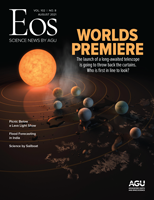The whole field of exoplanet study is frustratingly tantalizing. We now know for sure there are alien worlds. We can see them! Kinda. We see their shadows; we can see their fuzzy outlines. We are so close to the tipping point of having enough knowledge to truly shake our understanding—in the best way, says this space geek—of Earth’s place in the universe.
The first light of the James Webb Space Telescope (JWST) may be what sends us over that exciting edge. In just a few months, the much-delayed launch will, knock on wood, proceed from French Guiana and take around a month to travel to its destination at the second Lagrange point (L2). “This is certainly an exciting time for exoplanet science, with current missions like Hubble and TESS [Transiting Exoplanet Survey Satellite] providing us with new discoveries and future missions like JWST, which promises to provide incredible new data that will answer some of our current questions and also create many new ones,” said Sarah Hörst of Johns Hopkins University, Eos‘s Science Adviser representing AGU’s Planetary Sciences section who consulted on this issue. “The field is moving very quickly right now.”
That’s why our August issue is all about exoplanets—what we know and what awaits us over the launch horizon. Who gets the first peek through JWST? In March, the proposals selected for the first observing cycle were announced. Meet the slate of scientists who will be pointing the telescope at other worlds, and read what they hope to learn in “Overture to Exoplanets.”
As with all new instruments, the data collected from JWST will be pieced together with observations from ongoing missions and other facilities around the world. “Over the last decade, we’ve gotten gorgeous images from the ALMA interferometer in Chile and have seen loads of fine-scale structure, tracing pebbles in planet-forming disks,” says astronomer Ilse Cleeves in our feature article. Hörst found this synergy with ALMA (Atacama Large Millimeter/submillimeter Array) especially intriguing: “Although I’ve thought a lot about what we’ll learn about individual planets, I hadn’t really thought much about what we’ll be able to learn about planet formation process by studying the disks themselves.”
“I’m excited for all the ‘well, that’s weird’ moments. Those are my favorite things in science because that’s when you know that new discoveries are going to be made.”
In “The Forecast for Exoplanets Is Cloudy but Bright,” we learn the immense challenge posed by exoplanet atmospheres, when researchers are still struggling to understand the complex dynamics of clouds on our own planet. And in “Exoplanets in the Shadows,” we look at the rogues, the extremes, and a new field being coined as necroplanetology.
What awaits us when the first science results start coming in from JWST and all the coordinated missions next year? “I’m really excited for the unexpected,” says Hörst. “I’m excited for all the ‘well, that’s weird’ moments. Those are my favorite things in science because that’s when you know that new discoveries are going to be made. I’m also really happy for all of my colleagues who have worked so tirelessly for so many years to make JWST happen.”
We’re pretty happy, too, for the scientists long awaiting this day and for the rest of us who eagerly await a wide new window on our mysterious universe.
—Heather Goss (@heathermg), Editor in Chief, Eos
Citation:
Goss, H. (2021), Unveiling the next exoplanet act, Eos, 102, https://doi.org/10.1029/2021EO161111. Published on 26 July 2021.
Text © 2021. AGU. CC BY-NC-ND 3.0
Except where otherwise noted, images are subject to copyright. Any reuse without express permission from the copyright owner is prohibited.


